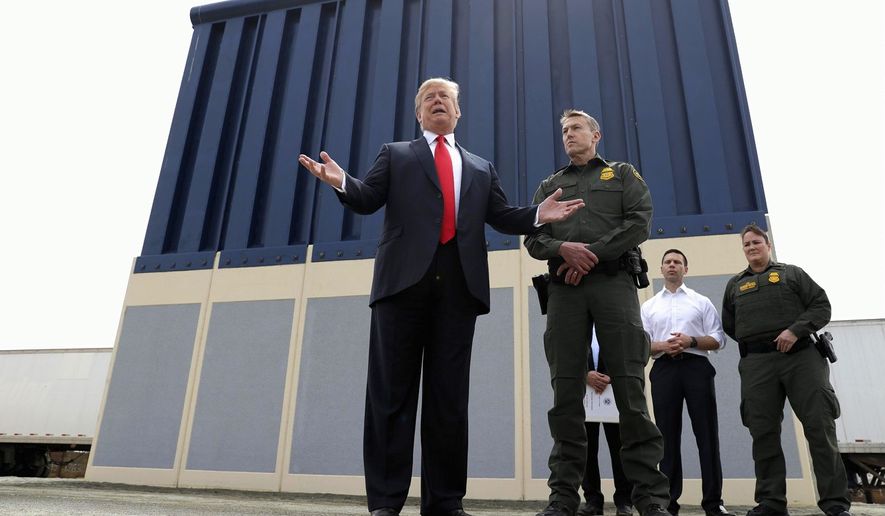Homeland Security began building a border wall in New Mexico on Monday, moving to replace vehicle barriers and outdated mesh fencing with a modern wall that will deter pedestrians attempting to cross in the remove desert west of El Paso.
The 20-mile project has been on the books for some time and the contract was awarded in January, but officials said President Trump gets the credit for making it happen.
The announcement came the same day as 225 National Guard troops deployed in neighboring Arizona, backing up Mr. Trump’s order last week that could send as many as 4,000 troops to the southwest to help with surveillance, construction and other support tasks. Texas also joined in Monday, as Gov. Greg Abbott said he’d quadruple the number of Guard troops on the border, from 250 to at least 1,000.
Both the wall and more personnel have been key goals for the president, who after overseeing major successes at the border early in his tenure is now watching a massive surge of border jumpers. Last month’s total was three times the rate of March 2017.
“Whether you’re a Republican or a Democrat, we need a wall,” Mr. Trump said at a Cabinet meeting Monday morning. “It will stop a lot of people we don’t want coming in this country.”
The new fencing going up in New Mexico will replace 20 miles of substandard barriers.
SEE ALSO: Environmental group asks appeals court block Trump wall
Some of it is vehicle barrier, which consists of connected sections of T-shaped bars, with the crossbar set about belt-high. They can hinder a car or truck, but are easy to climb over or under for smugglers and migrants on foot.
Aaron A. Hull, chief patrol agent for the El Paso Sector of the Border Patrol, said they’ll also replace some mesh fencing that’s easy to cut through and relatively easy to climb over.
The replacement will be bollard-style fencing, which consists of alternating vertical poles packed together so tightly that even an arm couldn’t be stuck through — yet still giving visibility to the Mexican side. The fence will range from 18 to 30 feet high, depending on the terrain. The top five feet is a solid plate which makes it difficult to scale.
“It’s going to be harder to get over, harder to get through, harder to get underneath,” the chief said. “It’s going to deter all but the most determined illegal entrants.”
The New Mexico wall contract went to Barnard Construction, a Montana-based company. At $73 million, it works out to less than $4 million per mile of fencing — far cheaper than estimates for the rest of Mr. Trump’s wall, which is pegged at about $25 million per mile.
The New Mexico project joins another wall replacement project in southern California that started last month.
Environmental groups sued last year trying to block construction, but a judge ruled against them, saying the administration had followed the law. The groups on Monday announced they’ve appealed to the 9th U.S. Circuit Court of Appeals, asking the judges there to block the president.
“Trump is ignoring bedrock environmental protections and relying on a congressional waiver that expired years ago,” said Brian Segee, a senior attorney at the Center for Biological Diversity. “He’s on a rampage to fulfill a hateful political promise, bulldozing forward with no concern for how much damage these walls will inflict on communities and wildlife.”
The environmentalists say Homeland Security is misusing laws passed in the 1990s and last decade allowing environmental laws to be waived in order to build the fence. But Judge Gonzalo Curiel, an Obama appointee to the court who had been the personal target of a vicious attack by Mr. Trump during the 2016 campaign, sided with the Trump administration earlier this year.
For now, Mr. Trump has a free hand to build his wall — or at least as much of it as Congress has authorized funding for. The administration says the 2018 spending bill will allow them to build 100 miles of new or replacement fence.
The New Mexico project predates the 2018 bill.
Homeland Security officials said with Ciudad Juarez, a Mexican city of nearly 2 million people, so close to the spot, the vehicle barriers are no longer considered effective enough.
The barriers are a legacy of the Bush fence-building push of a decade ago. Originally, Congress had ordered 700 miles of the border to be sealed with double-tier full-sized fencing, but the Bush administration balked and Congress backed off its demands, leaving decisions in the hands of Homeland Security.
The result was 354 miles of border protected by a pedestrian fence and 300 miles protected by vehicle barriers.
Now the Trump administration is going back to replace some of the vehicle barriers with the most up-to-date fencing.
• Stephen Dinan can be reached at sdinan@washingtontimes.com.




Please read our comment policy before commenting.